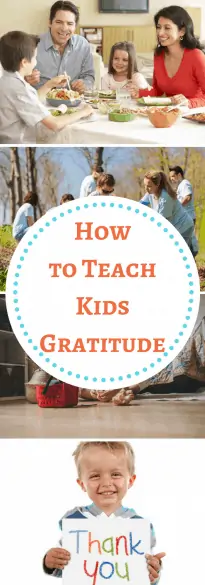It’s easy to think that teaching kids gratitude is about politeness and having good manners. And those things are absolutely part of it. But more importantly, when you teach kids gratitude you are teaching them how to be happy. True gratitude is about more than saying thank you or feeling pleased when things are going your way. It’s about feeling satisfied with and appreciative of what you have. The truth is it’s impossible to be truly happy, or even better, joyful, without practicing gratitude. Here are some practical ways to teach kids gratitude.
5 Simple Ways to Teach Kids Gratitude
1. Talk About It
As with so many things, the best way to teach kids gratitude is to show them what it looks like. Since gratitude is often internal, make an effort to express it out loud with your kids. Counting blessings at dinner can happen more often than at Thanksgiving. Consider going around the table each night and having everyone name something they are grateful for. This works well as part of a bedtime routine as well.
As wonderful as gratitude rituals can be, you don’t need to wait for a specific time of day to teach kids about gratitude. Look for teaching moments throughout the day and talk about them. This can be as simple as expressing pleasure in a sunny day or a nice walk, a play date that went well or a visit with family. Talk to your kids about the simple joys you’re all experiencing and how grateful you are to have them.
And finally, talk to your kids about how grateful you are to have them! Tell your kids why they are special and how much joy they bring to your life. It’s a wonderful way to show love and gratitude.
2. Make Them Work For What They Want
It’s easy to take the good things in life for granted when they come to us without effort. When kids are given everything they want on demand it’s easy for them to feel entitled instead of grateful.
If your child is yearning for a specific toy or even a special outing or experience, have them earn it. You can do this with chores or job money. Or something less formal. Perhaps if they help you out with a household project or meet a goal you set together you will purchase the toy.
Saving for and earning the things you want teaches important lessons. It teaches patience, hard work and the value of a dollar. Helping with household chores or projects can also teach kids to appreciate what you do for them as a parent. Rather than everything magically being cleaned or cooked or other things around the house done, they experience that it takes work. And hopefully, develop an appreciation for the things that get done for them.
3. Teach Them to Help Others
Teaching your kids to give generously is an important part of teaching gratitude. There are many ways to teach your kids about giving. You can participate in a volunteer event as a family. Or ask them to help you find gently used items to donate, including perhaps a few of their toys.
As kids get older, consider having them set aside a small portion of their allowance and then research a cause they would like to support with it.
Helping others feels good. It’s not something kids will learn on their own, or from you telling them. It’s really something they need to experience for themselves. Generously giving of yourself helps you feel gratitude for all you’ve been given and your ability to share that with others. Lessons in compassion and gratitude go hand in hand.
4. Practice Minimalism
The more you have, the less you appreciate it. When kids are given everything they want the minute they want it they never learn to appreciate what they have. A lifetime pursuit of the next new, bigger, better thing is a recipe for unhappiness.
I am absolutely guilty of buying my kids too many things. And from personal experience, I’ve learned it doesn’t make them happy or grateful. Now we are working on enjoying having a little bit less.
When kids have fewer toys they appreciate each and every one more. They learn to value their possessions and to take care of them. When your kids’ bedroom or playroom is full to the rafters of toys and games and crafts, they hardly have any space left to enjoy playing with any of it. Let alone feel grateful for what they have.
You don’t need to adopt a new lifestyle or make them sleep in a bare room to teach kids gratitude. But consider whether you give too much or too easily when they ask for things they don’t need. Or when they request new things when they don’t play with any of the old. Consider what small steps you can take to reduce the amount of stuff in your family’s life and home. Leaving room for less stuff makes more room for gratitude.
5. Teach Kids How to Show Appreciation
Learning to show appreciation is an important part of teaching kids gratitude. The thank you note is one of the best ways to demonstrate appreciation and your kids should be writing them when they receive gifts. Or drawing them as the case may be with younger children. More than simple good manners, this helps kids reflect on other’s generosity and kindness to them.
Beyond thank you notes, there are plenty of ways to demonstrate appreciation in daily life. At home, make sure you thank your spouse and your kids when they do something kind or helpful. This demonstrates gratitude and also shows kids how nice it is to be appreciated.
Outside the home, make sure you thank waitstaff in restaurants, or your bank teller or grocery clerk. Show your kids how to make others feel appreciated. And teach them how important it is to value the services others provide for us. And not take people for granted.
An Attitude of Gratitude
When I think about the happiest people I know, they all have one thing in common, an attitude of gratitude. It’s important to remember self-centeredness is natural in young children. And gratitude isn’t something we’re born with. But it is infinitely valuable. And you can teach it to your children. They will always be grateful you did.






